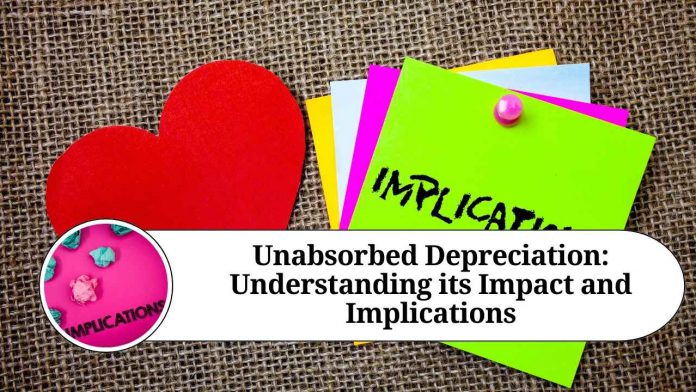Introduction
Depreciation is a crucial accounting concept that recognizes the decrease in value of tangible assets over time. It allows businesses to allocate the cost of an asset over its useful life. However, there are instances where the full amount of depreciation cannot be utilized within a specific period, leading to unabsorbed depreciation. In this blog, we will delve into the concept of unabsorbed depreciation, explore its causes, and discuss its implications for businesses.
Understanding Unabsorbed Depreciation:
Unabsorbed depreciation refers to the portion of depreciation that remains unutilized or unclaimed in a given financial year. It occurs when the depreciation expense exceeds the taxable income of a business, resulting in an inability to offset the full amount of depreciation against profits.
Causes of Unabsorbed Depreciation:
Low profits or losses:
If a business is experiencing a low-profit margin or operating at a loss, the depreciation expense may exceed the available taxable income. In such cases, the excess depreciation is carried forward as unabsorbed depreciation.
Changes in tax laws:
Modifications in tax regulations or rates can impact the absorption of depreciation. If the depreciation rates are reduced or the tax laws are amended, businesses may face unabsorbed depreciation due to misalignment between depreciation charges and the new tax provisions.
Capital-intensive industries:
Industries that heavily rely on capital investments, such as manufacturing or infrastructure, often incur substantial depreciation expenses. If the income generated by these businesses does not match the depreciation charges, unabsorbed depreciation can accumulate.
Implications of Unabsorbed Depreciation:
Deferred tax benefits:
Unabsorbed depreciation can be carried forward to future years, allowing businesses to offset it against taxable income in subsequent periods. This provision helps in reducing tax liabilities once profitability improves, thus providing a deferred tax benefit.
Increased tax liability:
While unabsorbed depreciation can provide tax relief in the future, it can also result in increased tax liability in the short term. Since the unabsorbed depreciation cannot be claimed immediately, businesses may need to pay higher taxes if their taxable income exceeds the unabsorbed depreciation amount.
Impact on financial statements:
Unabsorbed depreciation affects the financial statements of a business. It is usually disclosed as a separate line item in the balance sheet, indicating the amount of unabsorbed depreciation carried forward. This disclosure ensures transparency and assists stakeholders in understanding the financial position of the company.
Managing Unabsorbed Depreciation:
Strategic tax planning:
Businesses can employ tax planning strategies to optimize their depreciation claims and minimize unabsorbed depreciation. This may involve aligning asset acquisition decisions with depreciation provisions and tax regulations.
Forecasting and budgeting:
Accurate financial forecasting and budgeting can help anticipate potential unabsorbed depreciation situations. By estimating future profitability and tax liabilities, businesses can plan accordingly to utilize or carry forward the depreciation efficiently.
Regular review of tax laws:
Staying updated with tax laws and regulations is crucial for businesses to adapt their strategies and optimize their depreciation claims. Regular reviews can help identify changes that may affect the absorption of depreciation and allow proactive measures to be taken.
Conclusion
Unabsorbed depreciation can be a challenging aspect of tax management for businesses. Understanding its causes and implications is essential for effective financial planning and decision-making. By employing strategic tax planning, forecasting, and staying informed about tax regulations, businesses can better manage unabsorbed depreciation and optimize their tax liabilities in the long run.
Frequently As
Read more useful content:
ked Questions (FAQs)
Q1: What is unabsorbed depreciation?
A1: Unabsorbed depreciation refers to the portion of depreciation that remains unutilized or unclaimed in a given financial year. It occurs when the depreciation expense exceeds the taxable income of a business, resulting in an inability to offset the full amount of depreciation against profits.
Q2: What causes unabsorbed depreciation?
A2: Unabsorbed depreciation can be caused by factors such as low profits or losses, changes in tax laws, and operating in capital-intensive industries. Low profitability or losses may lead to insufficient taxable income to absorb the full depreciation expense. Changes in tax laws, such as reduced depreciation rates, can also result in unabsorbed depreciation. Additionally, businesses operating in industries that require substantial capital investments may face unabsorbed depreciation if income does not match depreciation charges.
Q3: How does unabsorbed depreciation impact taxes?
A3: Unabsorbed depreciation can have both short-term and long-term tax implications. In the short term, if taxable income exceeds the amount of unabsorbed depreciation, businesses may need to pay higher taxes. However, unabsorbed depreciation can be carried forward to future years, providing a deferred tax benefit. Once profitability improves, businesses can offset the unabsorbed depreciation against taxable income, reducing their tax liabilities.
Q4: How is unabsorbed depreciation managed?
A4: Businesses can manage unabsorbed depreciation through strategic tax planning, accurate financial forecasting and budgeting, and staying updated with tax laws. Strategic tax planning involves aligning asset acquisition decisions with depreciation provisions and tax regulations to optimize depreciation claims. Accurate financial forecasting and budgeting help anticipate and plan for potential unabsorbed depreciation situations. Staying informed about tax laws enables businesses to adapt their strategies and optimize their depreciation claims accordingly.
Q5: How is unabsorbed depreciation reflected in financial statements?
A5: Unabsorbed depreciation is typically disclosed as a separate line item in the balance sheet of a business. This disclosure indicates the amount of unabsorbed depreciation carried forward from previous years. By disclosing unabsorbed depreciation, businesses provide transparency in their financial statements and allow stakeholders to understand the impact of unabsorbed depreciation on the company’s financial position.
Q6: Can unabsorbed depreciation be carried forward indefinitely?
A6: The carry-forward period for unabsorbed depreciation varies across countries and tax jurisdictions. In some cases, unabsorbed depreciation can be carried forward indefinitely until it is fully utilized. However, specific time limits may apply in certain jurisdictions, requiring businesses to utilize unabsorbed depreciation within a certain number of years. It is important to consult tax laws and regulations applicable to the specific jurisdiction for accurate information on carry-forward periods.




















